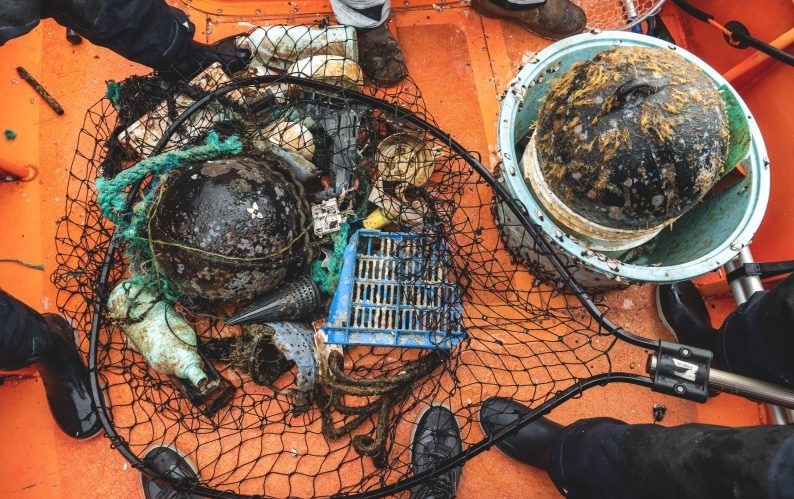Many coastal marine invertebrate species have invaded the high seas, where they can now thrive and breed, significantly adding to the floating community composition. A team of researchers led by the Smithsonian Environmental Research Center (SERC) and the University of Hawai’i (UH) at Mānoa published their findings in Nature Ecology and Evolution on April 17th, 2023.
 Floating plastics collected in the North Pacific Subtropical Gyre during The Ocean Cleanup’s 2018 expedition. Image Credit: The Ocean Cleanup
Floating plastics collected in the North Pacific Subtropical Gyre during The Ocean Cleanup’s 2018 expedition. Image Credit: The Ocean Cleanup
The researchers discovered coastal species from several taxonomic groupings and life history features on more than 70% of the plastic waste they investigated in the eastern North Pacific Subtropical Gyre. Coastal species outnumbered open ocean species among the debris.
This discovery suggests that past biogeographical boundaries among marine ecosystems—established for millions of years—are rapidly changing due to floating plastic pollution accumulating in the subtropical gyres.
Linsey Haram, Study Lead Author and Former Postdoctoral Research Fellow, Smithsonian Environmental Research Center
These “neopelagic communities,” or floating communities in deep ocean waters, were recently identified by these researchers. SERC and UH Mānoa developed a multi-disciplinary Floating Ocean Ecosystem (FloatEco) team to better understand the ecological and physical mechanisms that regulate communities on floating marine trash.
SERC analyzed the study’s biological and ecological dimensions, while UH Mānoa assessed physical oceanography.
For this study, the FloatEco team studied 105 plastic samples collected by The Ocean Cleanup during their trips to the North Pacific Subtropical Gyre, which covers most of the northern Pacific Ocean. Individual volunteers and other non-governmental groups were involved in the fieldwork.
Haram added, “We were extremely surprised to find 37 different invertebrate species that normally live in coastal waters, over triple the number of species we found that live in open waters, not only surviving on the plastic but also reproducing. We were also impressed by how easily coastal species colonized new floating items, including our own instruments—an observation we are looking into further.”
Gregory Ruiz, a senior scientist at SERC and the study’s co-author, added, “Our results suggest coastal organisms now are able to reproduce, grow, and persist in the open ocean—creating a novel community that did not previously exist, being sustained by the vast and expanding sea of plastic debris. This is a paradigm shift in what we consider to be barriers to the distribution and dispersal of coastal invertebrates.”
Scientists were previously unclear that established coastal communities could endure in the open ocean, even though they already recognized that organisms, including some coastal species, colonized marine plastic trash.
The scope and possible effects of this newly discovered human-caused influence on the ocean are documented. These facts were previously unknown.
The Hawaiian Islands are neighbored in the northeast by the North Pacific garbage patch. Debris that breaks off from this patch constitutes the majority of debris arriving on Hawaiian beaches and reefs. In the past, the fragile marine ecosystems of the islands were protected by the very long distances from coastal communities of Asia and North America.
Nikolai Maximenko, Study Co-Author and Senior Researcher, School of Ocean and Earth Science and Technology, University of Hawai’i at Mānoa
Maximenko further added, “The presence of coastal species persisting in the North Pacific Subtropical Gyre near Hawai’i is a game changer that indicates that the islands are at an increased risk of colonization by invasive species.”
Ruiz concluded, “Our study underscores the large knowledge gap and still limited understanding of rapidly changing open ocean ecosystems. This highlights the need for dramatic enhancement of the high-seas observing systems, including biological, physical, and marine debris measurements.”
Journal References
Haram, L. E., et al. (2023) Extent and reproduction of coastal species on plastic debris in the North Pacific Subtropical Gyre. Nature Ecology and Evolution. doi:10.1038/s41559-023-01997-y
Haram, L. E., et al. (2021) Emergence of a neopelagic community through the establishment of coastal species on the high seas. Nature Communications. doi:10.1038/s41467-021-27188-6